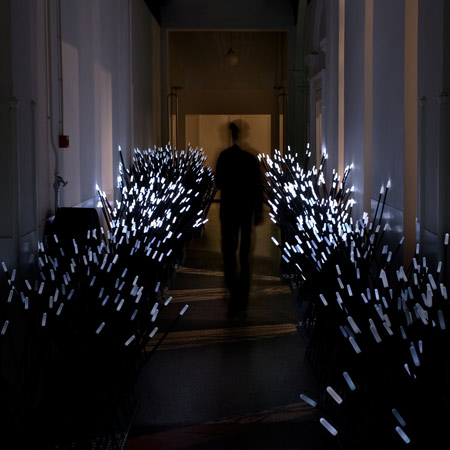An exhibition of digital and interactive design called Decode: Digital Design Sensations has opened at the Victoria & Albert Museum in London.
Above: Flight Patterns by Aaron Koblin, 2006. Top Image: Dune by Daan Roosegaarde, 2006-2009. Photo by Daan Roosegaarde
The exhibition, co-curated with digital arts organisation onedotzero, features artists and designers such as Daniel Brown and Golan Nevin and explores the themes Code as Raw Material, Interactivity and The Network.
Above: Radiohead, House of Cards, 2008. Technical Director: Aaron Koblin, Director: James Frost, Production Company: Zoo Films, Los Angeles. Image courtesy of Xurbia Xendless Ltd
The V&A has also commissioned digital work specially for the exhibition microsite, which will also allow remote access to some of the work on display in the gallery.
Above: Weave Mirror by Daniel Rozin, 2007. Photo by John Berens, courtesy of bitforms gallery NYC
The exhibition opened last week and continues until the 11 April 2010.
Above: Audience by rAndom international, 2009. Photo courtesy of Carpenters Workshop Gallery, London
Photos courtesy of the V&A unless stated otherwise.
Above: Zoetrope by Troika, 2008. Photo by Alex Delfanne
Here's more information from the V&A:
--
Decode: Digital Design Sensations
In partnership with SAP
8 December 2009 – 11 April 2010
Digitally growing plants and a mechanical eye that mirrors the blink of a visitor’s gaze will be among the digital works that will feature in Decode: Digital Design Sensations. The exhibition will show the latest developments in digital and interactive design, from small screen based graphics to large-scale installations.
Above: TI by C.E.B. Reas, 2004
Curated in collaboration with leading digital arts organisation onedotzero, there will be works by established international artists and designers including Daniel Brown, Golan Levin and Daniel Rozin as well as emerging designers such as Troika and Simon Heijdens.
Above: Flow 5.0 by Daan Roosegaarde, 2007-2009. Photo by Daan Roosegarde. See Dezeen's story about this project here.
The exhibition will be centred in the Porter Gallery with a series of interventions throughout the Museum and garden as well as a number of specially commissioned one-off performances. For the first time, the V&A is also commissioning a digital work for its website and will provide remote access to some of the works on display.
Above: Body Paint by Mehmet Akten, 2009
The exhibition will explore three themes. Code as a Raw Material will present pieces that use computer code to create new designs in the same way a sculptor works with materials such as clay or wood. This section will look at how code can be programmed to create constantly fluid and ever changing objects.
Above: Dandelion by Sennep/ Yoke, 2006
Photo by Sennep
On display will be a new piece by Daniel Brown from his On Growth and Form series, inspired by the V&A’s collection. Brown uses advanced mathematics to generate organic depictions of imaginary plants that continuously grow, producing new buds, blossoms and stalks. As soft, organic digital images, these generative flowers will continue to develop and grow over the course of the exhibition.
Above and below: Tree by Simon Heijdens, 2004
The second theme, Interactivity, will look at designs where the viewer directly influences the work. Visitors will be invited to interact with and contribute to the development of the works, many of which show designers playing with the boundaries of design and performance.
One object will be Golan Levin’s Opto-Isolator, a humansized mechanical eye which follows the gaze of the viewer, blinking one second after its visitor blinks.
Above: On Growth and Form series by Daniel Brown, 2009
Weave Mirror by Daniel Rozin is a responsive sculpture that recreates an image of the viewer on its 768 motorized planes. A smoky portrait comes into focus as the planes rotate into place.
Above: Oasis II by Everyware, 2008
The final theme, The Network, will focus on works that comment on and utilise the digital traces left behind by everyday communications, from blogs in social media communities to mobile communications or satellite tracked GPS systems.
Above: Nature by John Maeda, 2007
This section explores how advanced technologies and the internet have enabled new types of social interaction and media for self expression. Designers reinterpret this information to create works that translate data into striking forms.
These range from live, real-time visualisations of flight patterns by Aaron Koblin to a data mining project by Jonathan Harris and Sep Kamvar. Their project We Feel Fine extracts comments by bloggers from all over the world on how they are feeling and represents the information as colourful, floating spheres. Users can filter the information by selecting an emotion as well as bloggers’ gender, age and the city and weather conditions where he or she is based to reveal anonymous, often highly personal, statements about modern life today.
About onedotzero
onedotzero is a London-based moving image and digital arts organisation that commissions, showcases and promotes innovation across all aspects of moving image, digital and interactive arts. The organisation, founded in 1996, is known for representing a diverse array of artistic endeavour. It has a cross media and collaborative approach attuned to technological advances and fast paced change within digital arts and the contemporary culture landscape.
Decode: Digital Design Sensations is on display now in the V&A’s Porter Gallery and will run until Sunday 11 April 2010.
Above: Videogrid by Ross Phillips, 2008
Above and below: Opto-Isolator by Golan Levin with Greg Balthus. Photo by John Berens, courtesy of bitforms gallery nyc

